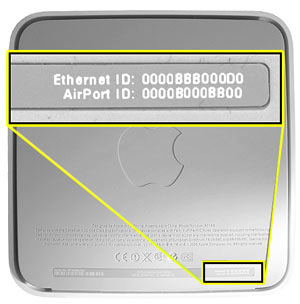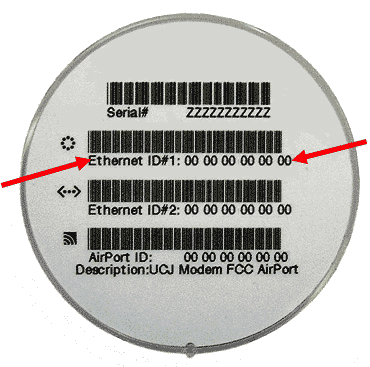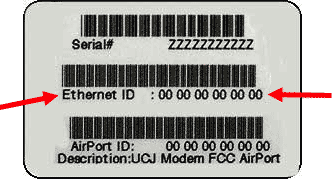AirPort Base Station: ISP provisioning may prevent Internet connection via broadband (cable or DSL)
Some Internet service providers use a method called "hardware access provisioning" to regulate access to their networks. It normally means that only one of your devices (such as a computer, base station, or router) can connect directly to your modem at any given time.
Tip: Multiple computers connecting to the modem through an AirPort base station would only count as one device to the modem. That's because the AirPort base station can give private IP addresses to the computers.
Provisioning in action
Suppose that you have one computer in your home, an iMac that successfully connects to the Internet through a cable modem. Subsequently you purchase an AirPort Extreme base station and a Macbook Pro.
To get all three devices on the Internet, you would disconnect the Ethernet cable from the iMac and plug it into the WAN port on the base station instead. Then you would get an additional Ethernet cable to run between the iMac and one of the AirPort base station's LAN ports. The Macbook Pro would connect to the base station wirelessly.
The setup would look like this:

You've done everything right, but still can't connect to the Internet. Why?
It is likely that the modem locked onto your iMac, and it will ignore anything else you plug into it until the modem has been reset. If you were to plug the iMac back into the modem, it would still connect to the Internet.
Fortunately, resetting a broadband modem is usually very easy -- just unplug its power supply, wait a moment, and plug it back in. After its indicator lights have gone through their startup routine, you should do the same to the AirPort base station.
Odds are that you can connect to the Internet now. If not, the more detailed information that follows can help you troubleshoot the situation further.
Provisioning in depth
What is a Hardware Address?
An Ethernet device, like your computer or base station, is exposed to all information transmitted over the network segment that it is on, but it only "listens" to specific pieces of information (called "packets") that contain the unique identifying number of your Ethernet device. This unique number is commonly referred to as either a "hardware address" or a "media access control (MAC) address." It is a 12-digit hexadecimal number. Every addressable hardware product used for networking is required to have a unique MAC address permanently embedded in it.
What is Hardware Address Provisioning?
Some Internet service providers only accept packets that contain your device's MAC address, thus controlling access to the network. This practice is called "hardware access provisioning."
For example: Suppose that you have a computer connected to a cable modem before purchasing an AirPort Base Station. Your Internet service provider might recognize your computer's MAC address as the correct one for your account. Your new base station then takes the position on your network that was formerly occupied by your computer, but you have not taken any action to let your Internet service provider (or its hardware) know the new address. The base station then sends packets to your Internet service provider that do not contain the required MAC address, and the packets are ignored.
How to resolve a provisioning issue
Methods used by service providers for determining what your MAC address should be varies, affecting how you must resolve the situation:
Reset network hardware
A cable or DSL modem may simply record the address of the device that is connected to it when the modem is turned on or plugged in. Unplugging, turning off/on, or resetting your cable or DSL modem may be all that is required for some Internet service providers.
Manual configuration
Your Internet service provider may ask you for your device's hardware address and enter it into their system manually. A technician may have collected this information when your service was first set up. In this case, you would contact your Internet service provider's technical support to have your hardware address updated.
How to find the MAC address
On Macintosh hardware, the hardware address is usually found on a label affixed to back or bottom of the device. The number that you are looking for is typically labeled "Ethernet ID" and is 12 digits long. The number may be located next to a bar code.
MAC addresses of a Time Capsule or AirPort Extreme Base Station:

MAC addresses of an older AirPort Base Station (Dual Ethernet):

MAC addresses of an AirPort Base Station (Graphite):

Choosing the correct address
Time Capsule or AirPort Extreme Base Station
Time Capsule and AirPort Extreme Base Stations have several MAC addresses, one for its Ethernet port and one or two for its wireless cards. Choose the number labeled "Ethernet ID".
AirPort Base Station (Dual Ethernet)
The white AirPort Base Station (Dual Ethernet) actually has three hardware addresses, one for a local wired network (the LAN port), one for uplinking to your Internet service provider (the WAN port), and a third for its wireless card. Connect your modem to the WAN port then choose the address labeled "Ethernet ID#1".
AirPort Base Station (Graphite)
The original AirPort Base Station (Graphite) has two MAC addresses, one for its Ethernet port and another for its wireless card. Choose the number labeled "Ethernet ID".
The LAN port icon.
The WAN port icon.